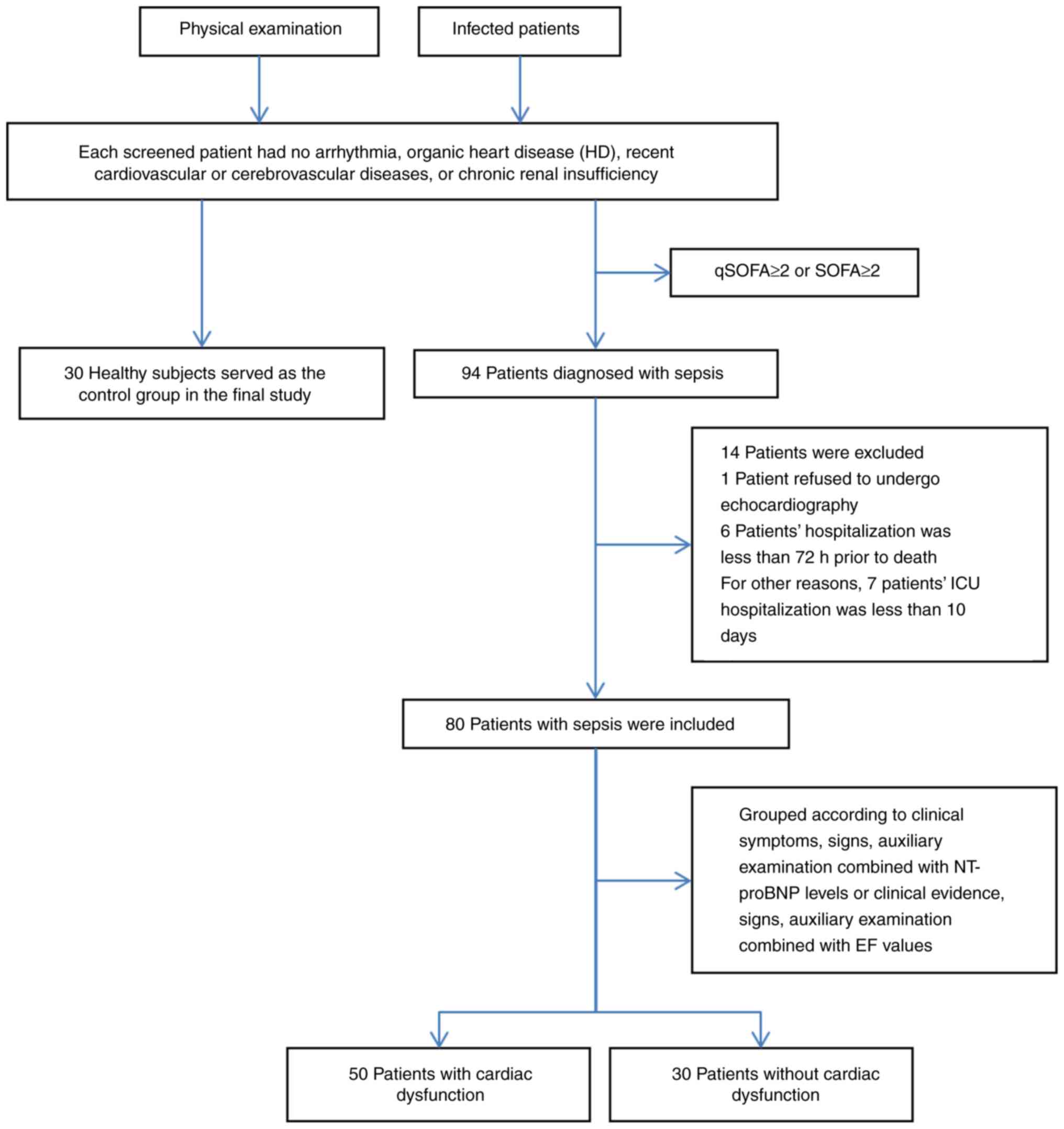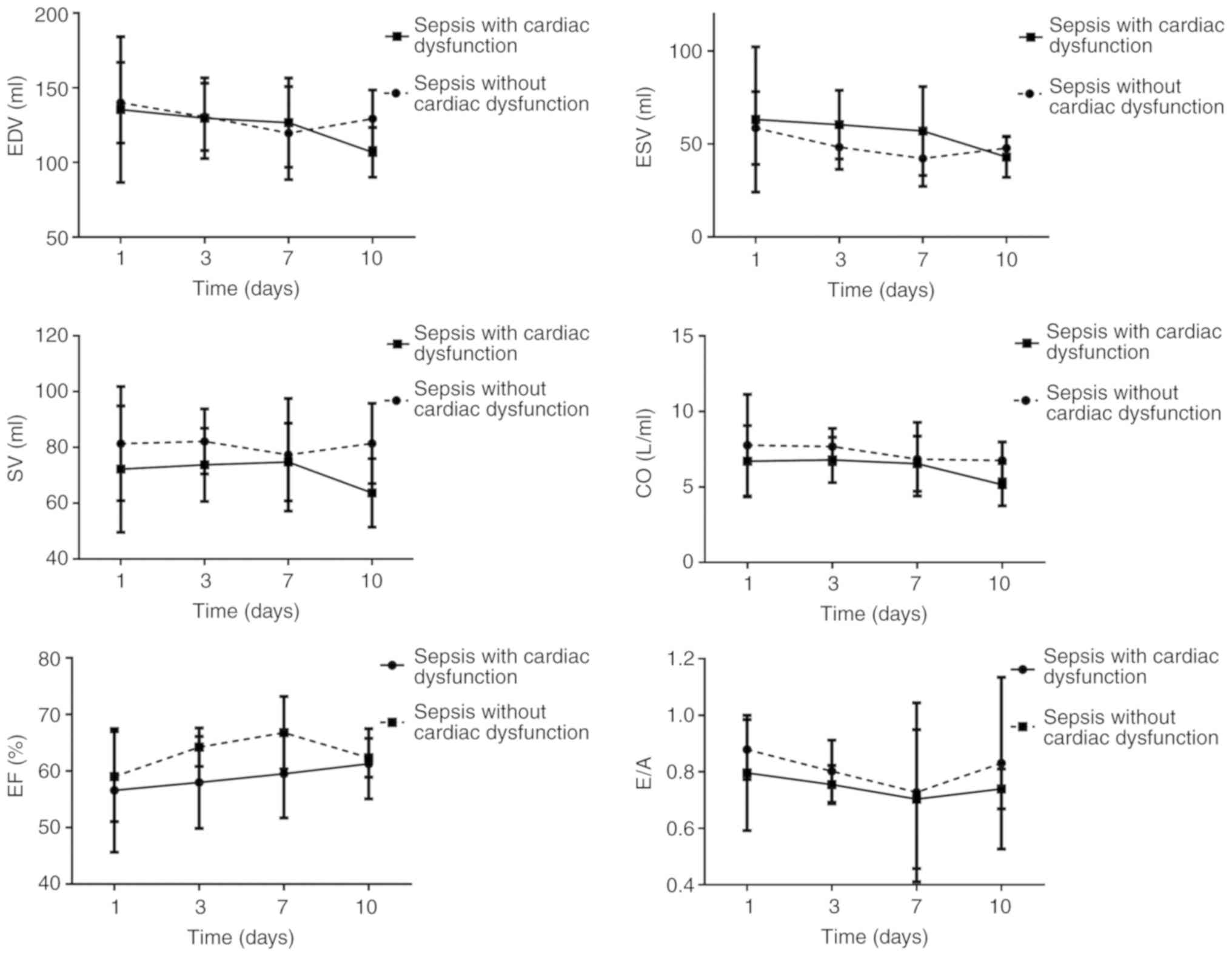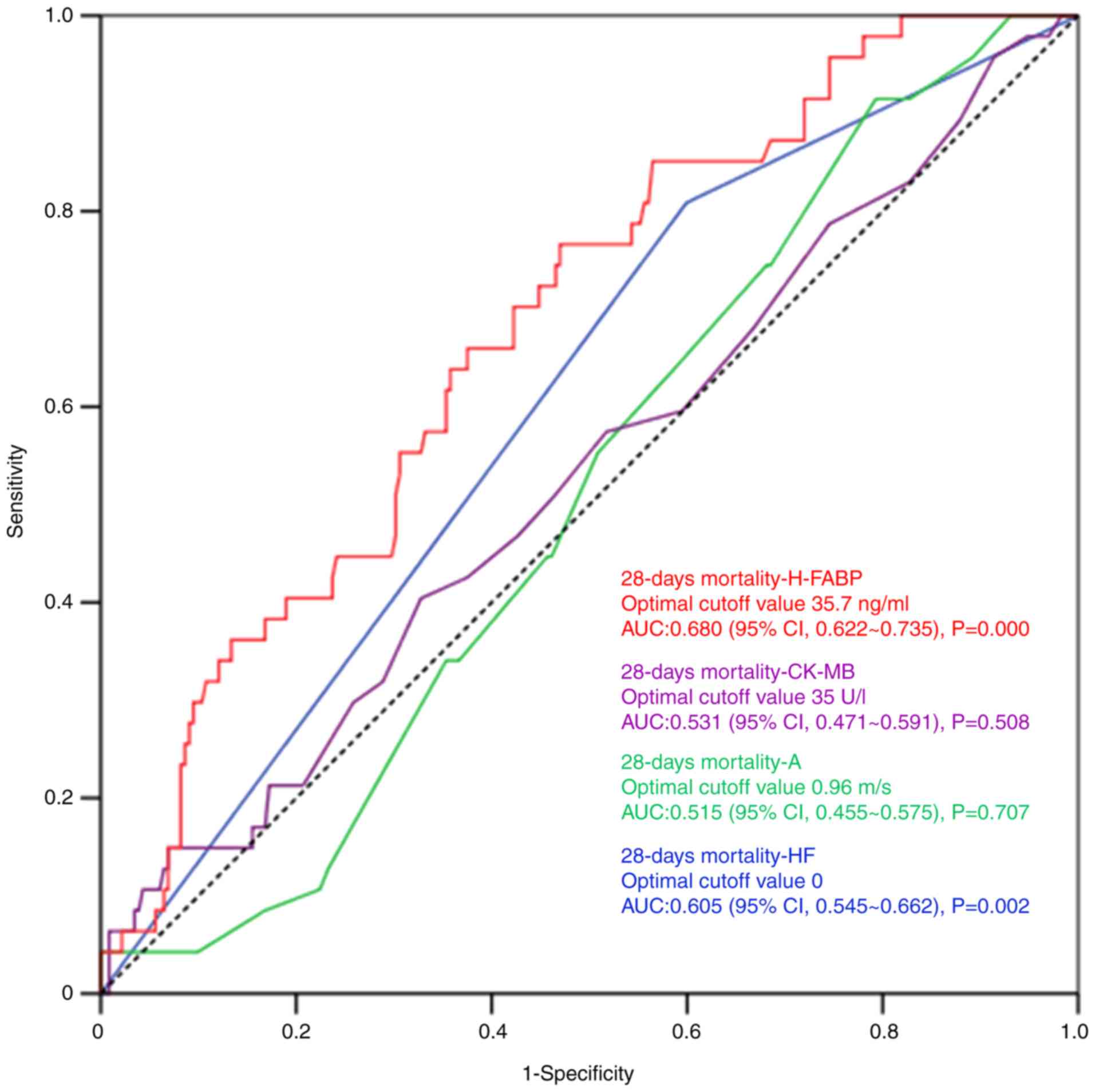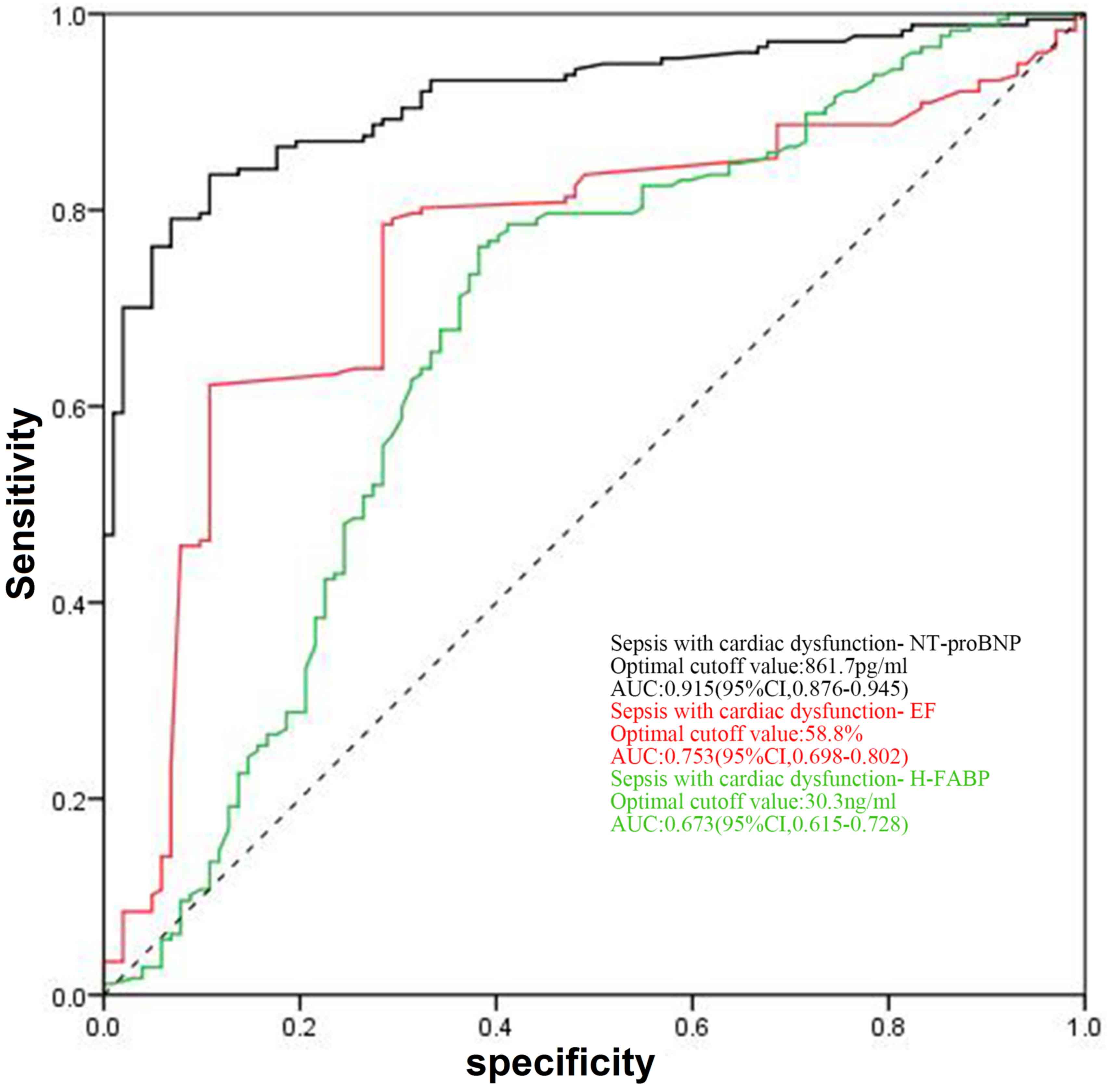|
1
|
Rhodes A, Evans LE, Alhazzani W, Levy MM,
Antonelli M, Ferrer R, Kumar A, Sevransky JE, Sprung CL, Nunnally
ME, et al: Surviving sepsis campaign: International guidelines for
management of sepsis and septic shock: 2016. Intensive Care Med.
43:304–377. 2017.PubMed/NCBI View Article : Google Scholar
|
|
2
|
Shankar-Hari M, Phillips GS, Levy ML,
Seymour CW, Liu VX, Deutschman CS, Angus DC, Rubenfeld GD and
Singer M: Sepsis Definitions Task Force. Developing a new
definition and assessing new clinical criteria for septic shock:
For the third international consensus definitions for sepsis and
septic shock (Sepsis-3). JAMA. 315:775–787. 2016.PubMed/NCBI View Article : Google Scholar
|
|
3
|
Zhou J, Qian C, Zhao M, Yu X, Kang Y, Ma
X, Ai Y, Xu Y, Liu D, An Y, et al: Epidemiology and outcome of
severe sepsis and septic shock in intensive care units in mainland
China. PLoS One. 9(e107181)2014.PubMed/NCBI View Article : Google Scholar
|
|
4
|
Zanotti-Cavazzoni SL and Hollenberg SM:
Cardiac dysfunction in severe sepsis and septic shock. Curr Opin
Crit Care. 15:392–397. 2009.PubMed/NCBI View Article : Google Scholar
|
|
5
|
Chong J, Dumont T, Francis-Frank L and
Balaan M: Sepsis and septic shock: A review. Crit Care Nurs Q.
38:111–120. 2015.PubMed/NCBI View Article : Google Scholar
|
|
6
|
Sanfilippo F, Corredor C, Fletcher N,
Landesberg G, Benedetto U, Foex P and Cecconi M: Erratum to:
Diastolic dysfunction and mortality in septic patients: A
systematic review and meta-analysis. Intensive Care Med.
41:1178–1179. 2015.PubMed/NCBI View Article : Google Scholar
|
|
7
|
Brennan LM, Widder MW, McAleer MK, Mayo
MW, Greis AP and van der Schalie WH: Preparation and testing of
impedance-based fluidic biochips with RTgill-W1 cells for rapid
evaluation of drinking water samples for toxicity. J Vis Exp,
2016.
|
|
8
|
Werdan K, Schmidt H, Ebelt H, Zorn-Pauly
K, Koidl B, Hoke RS, Heinroth K and Müller-Werdan U: Impaired
regulation of cardiac function in sepsis, SIRS, and MODS. Can J
Physiol Pharmacol. 87:266–274. 2009.PubMed/NCBI View
Article : Google Scholar
|
|
9
|
Rudski LG, Lai WW, Afilalo J, Hua L,
Handschumacher MD, Chandrasekaran K, Solomon SD, Louie EK and
Schiller NB: Guidelines for the echocardiographic assessment of the
right heart in adults: A report from the American society of
echocardiography endorsed by the European association of
echocardiography, a registered branch of the European society of
cardiology, and the canadian society of echocardiography. J Am Soc
Echocardiogr. 23:685–713. 2010.PubMed/NCBI View Article : Google Scholar
|
|
10
|
Group CMAUMBE. Chinese adult
echocardiography examination and measurement guide. Chin J
Ultrasonography. 25:645–666. 2016.(In Chinese).
|
|
11
|
Pulido JN, Afessa B, Masaki M, Yuasa T,
Gillespie S, Herasevich V, Brown DR and Oh JK: Frequency and
clinical spectrum of myocardial dysfunction in severe sepsis and
septic shock. Mayo Clin Proc. 87:620–628. 2012.PubMed/NCBI View Article : Google Scholar
|
|
12
|
Sato R, Kuriyama A, Takada T, Nasu M and
Luthe SK: Prevalence and risk factors of sepsis-induced
cardiomyopathy: A retrospective cohort study. Medicine (Baltimore).
95(e5031)2016.PubMed/NCBI View Article : Google Scholar
|
|
13
|
Yancy CW, Jessup M, Bozkurt B, Butler J,
Casey DE Jr, Colvin MM, Drazner MH, Filippatos GS, Fonarow GC,
Givertz MM, et al: 2017 ACC/AHA/HFSA focused update of the 2013
ACCF/AHA guideline for the management of heart failure: A report of
the American college of cardiology/American heart association task
force on clinical practice guidelines and the heart failure society
of America. J Am Coll Cardiol. 70:776–803. 2017.PubMed/NCBI View Article : Google Scholar
|
|
14
|
Kakihana Y, Ito T, Nakahara M, Yamaguchi K
and Yasuda T: Sepsis-induced myocardial dysfunction:
Pathophysiology and management. J Intensive Care.
4(22)2016.PubMed/NCBI View Article : Google Scholar
|
|
15
|
Sato R and Nasu M: A review of
sepsis-induced cardiomyopathy. J Intensive Care.
3(48)2015.PubMed/NCBI View Article : Google Scholar
|
|
16
|
Luo JQ, LI JC and Long ZH: The clinical
application of heart-fatty acid binding protein in AMI early
diagnosis. Chin J Clin Pathologist. 1:22–25. 2016.(In Chinese).
|
|
17
|
Zhang ZC, Dai HW, Yu YH, Yang JD and Hu
CB: Usefulness of heart-type fatty acid-binding protein in patients
with severe sepsis. J Crit Care. 27:e413–e415.e418. 2012.PubMed/NCBI View Article : Google Scholar
|
|
18
|
Chen YX and Li CS: The prognostic and
risk-stratified value of heart-type fatty acid-binding protein in
septic patients in the emergency department. J Crit Care.
29:512–516. 2014.PubMed/NCBI View Article : Google Scholar
|
|
19
|
You HJ, Kim K, Lee JH, Rhee JE, Lee JH,
Kang KW, Rim KP, Hwang SS and Park HM: Heart-type fatty
acid-binding protein as a prognostic factor in patients with severe
sepsis and septic shock. Am J Emerg Med. 30:1749–1755.
2012.PubMed/NCBI View Article : Google Scholar
|
|
20
|
Singer M, Deutschman CS, Seymour CW,
Shankar-Hari M, Annane D, Bauer M, Bellomo R, Bernard GR, Chiche
JD, Coopersmith CM, et al: The third international consensus
definitions for sepsis and septic shock (Sepsis-3). JAMA.
315:801–810. 2016.PubMed/NCBI View Article : Google Scholar
|
|
21
|
Nagueh SF, Smiseth OA, Appleton CP, Byrd
BF III, Dokainish H, Edvardsen T, Flachskampf FA, Gillebert TC,
Klein AL, Lancellotti P, et al: Recommendations for the evaluation
of left ventricular diastolic function by echocardiography: An
update from the American society of echocardiography and the
European association of cardiovascular imaging. J Am Soc
Echocardiogr. 29:277–314. 2016.PubMed/NCBI View Article : Google Scholar
|
|
22
|
Knaus WA, Draper EA, Wagner DP and
Zimmerman JE: APACHE II: A severity of disease classification
system. Crit Care Med. 13:818–829. 1985.PubMed/NCBI
|
|
23
|
Holubarsch C, Ruf T, Goldstein DJ, Ashton
RC, Nickl W, Pieske B, Pioch K, Ludemann J, Wiesner S, Hasenfuss G,
et al: Existence of the Frank-Starling mechanism in the failing
human heart Investigations on the organ, tissue, and sarcomere
levels. Circulation. 94:683–689. 1996.PubMed/NCBI View Article : Google Scholar
|
|
24
|
Shiels HA and White E: The frank-starling
mechanism in vertebrate cardiac myocytes. J Exp Biol.
211:2005–2013. 2008.PubMed/NCBI View Article : Google Scholar
|
|
25
|
Redfors B, Shao Y and Omerovic E: Male
rats are more prone to develop Takotsubo-like cardiac dysfunction
in response to high-dose catecholamine than are female rats. Eur
Heart J. 34(P5047)2013.
|
|
26
|
Chaui-Berlinck JG and Monteiro LHA:
Frank-Starling mechanism and short-term adjustment of cardiac flow.
J Exp Biol. 220:4391–4398. 2017.PubMed/NCBI View Article : Google Scholar
|
|
27
|
Parker MM, Shelhamer JH, Bacharach SL,
Green MV, Natanson C, Frederick TM, Damske BA and Parrillo JE:
Profound but reversible myocardial depression in patients with
septic shock. Ann Intern Med. 100:483–490. 1984.PubMed/NCBI View Article : Google Scholar
|
|
28
|
Khoury J, Arow M, Elias A, Makhoul BF,
Berger G, Kaplan M, Mashiach T, Ismael-Badarneh R, Aronson D and
Azzam ZS: The prognostic value of brain natriuretic peptide (BNP)
in non-cardiac patients with sepsis, ultra-long follow-up. J Crit
Care. 42:117–122. 2017.PubMed/NCBI View Article : Google Scholar
|
|
29
|
Lin CW, Tang W, Wen F, Chen JJ, Zeng XL
and Chen ZG: Diagnostic accuracy of NT-ProBNP for heart failure
with sepsis in patients younger than 18 years. PLoS One.
11(e0147930)2016.PubMed/NCBI View Article : Google Scholar
|
|
30
|
Storch J and Thumser AE: The fatty acid
transport function of fatty acid-binding proteins. Biochim Biophys
Acta. 1486:28–44. 2000.PubMed/NCBI View Article : Google Scholar
|
|
31
|
Smathers RL and Petersen DR: The human
fatty acid-binding protein family: Evolutionary divergences and
functions. Hum Genomics. 5:170–191. 2011.PubMed/NCBI View Article : Google Scholar
|
|
32
|
Wang Y, Guo Z and Huang L: Value of
different biochemical markers in early diagnosis of acute
myocardial infarction. Nan Fang Yi Ke Da Xue Xue Bao. 34:1347–1350.
2014.PubMed/NCBI(In Chinese).
|
|
33
|
Cubranic Z, Madzar Z, Matijevic S, Dvornik
S, Fisic E, Tomulic V, Kunisek J, Laskarin G, Kardum I and
Zaputovic L: Diagnostic accuracy of heart fatty acid binding
protein (H-FABP) and glycogen phosphorylase isoenzyme BB (GPBB) in
diagnosis of acute myocardial infarction in patients with acute
coronary syndrome. Biochem Med (Zagreb). 22:225–236.
2012.PubMed/NCBI View Article : Google Scholar
|
|
34
|
Jo YH, Kim K, Lee JH, Rhee JE, Lee JH,
Kang KW, Rim KP, Hwang SS and Park HM: Heart-type fatty
acid-binding protein as a prognostic factor in patients with severe
sepsis and septic shock. Am J Emerg Med. 30:1749–1755.
2012.PubMed/NCBI View Article : Google Scholar
|
|
35
|
Fan TT, Feng XY, Yang YZ, Gao F and Liu Q:
Downregulation of PI3K-g in a mouse model of sepsis-induced
myocardial dysfunction. Cytokine. 96:208–216. 2017.PubMed/NCBI View Article : Google Scholar
|
|
36
|
Hartemink KJ, Twisk JW and Groeneveld AB:
High circulating N-terminal pro-B-type natriuretic peptide is
associated with greater systolic cardiac dysfunction and
nonresponsiveness to fluids in septic vs nonseptic critically ill
patients. J Crit Care. 26:e101–e108. 2011.PubMed/NCBI View Article : Google Scholar
|
|
37
|
Tomaru Ki K, Arai M, Yokoyama T, Aihara Y,
Sekiguchi Ki K, Tanaka T, Nagai R and Kurabayashi M:
Transcriptional activation of the BNP gene by lipopolysaccharide is
mediated through GATA elements in neonatal rat cardiac myocytes. J
Mol Cell Cardiol. 34:649–659. 2002.PubMed/NCBI View Article : Google Scholar
|
|
38
|
Lorts A, Burroughs T and Shanley TP:
Elucidating the role of reversible protein phosphorylation in
sepsis-induced myocardial dysfunction. Shock. 32:49–54.
2009.PubMed/NCBI View Article : Google Scholar
|
|
39
|
Kandil E, Burack J, Sawas A, Bibawy H,
Schwartzman A, Zenilman ME and Bluth MH: B-type natriuretic
peptide: A biomarker for the diagnosis and risk stratification of
patients with septic shock. Arch Surg. 143:242–246. 2008.PubMed/NCBI View Article : Google Scholar
|
|
40
|
Landesberg G, Levin PD, Gilon D, Goodman
S, Georgieva M, Weissman C, Jaffe AS, Sprung CL and Barak V:
Myocardial dysfunction in severe sepsis and septic shock: No
correlation with inflammatory cytokines in real-life clinical
setting. Chest. 148:93–102. 2015.PubMed/NCBI View Article : Google Scholar
|
|
41
|
Yan GT, Lin J, Hao XH, Xue H, Zhang K and
Wang LH: Heart-type fatty acid-binding protein is a useful marker
for organ dysfunction and leptin alleviates sepsis-induced organ
injuries by restraining its tissue levels. Eur J Pharmacol.
616:244–250. 2009.PubMed/NCBI View Article : Google Scholar
|
|
42
|
Tanaka T, Hirota Y, Sohmiya K, Nishimura S
and Kawamura K: Serum and urinary human heart fatty acid-binding
protein in acute myocardial infarction. Clin Biochem. 24:195–201.
1991.PubMed/NCBI View Article : Google Scholar
|
|
43
|
Nagueh SF, Smiseth OA, Appleton CP, Byrd
BF III, Dokainish H, Edvardsen T, Flachskampf FA, Gillebert TC,
Klein AL, Lancellotti P, et al: Recommendations for the evaluation
of left ventricular diastolic function by echocardiography: An
update from the American society of echocardiography and the
European association of cardiovascular imaging. Eur Heart J
Cardiovasc Imaging. 17:1321–1360. 2016.PubMed/NCBI View Article : Google Scholar
|
|
44
|
Echocardiography Group of Ultrasound
Medicine Branch of Chinese Medical Association. Guide for Chinese
adult echocardiography examination and measurement. Chin J
Ultrasonogr. 25:645–666. 2016.
|
|
45
|
Landesberg G, Gilon D, Meroz Y, Georgieva
M, Levin PD, Goodman S, Avidan A, Beeri R, Weissman C, Jaffe AS and
Sprung CL: Diastolic dysfunction and mortality in severe sepsis and
septic shock. Eur Heart J. 33:895–903. 2012.PubMed/NCBI View Article : Google Scholar
|


















